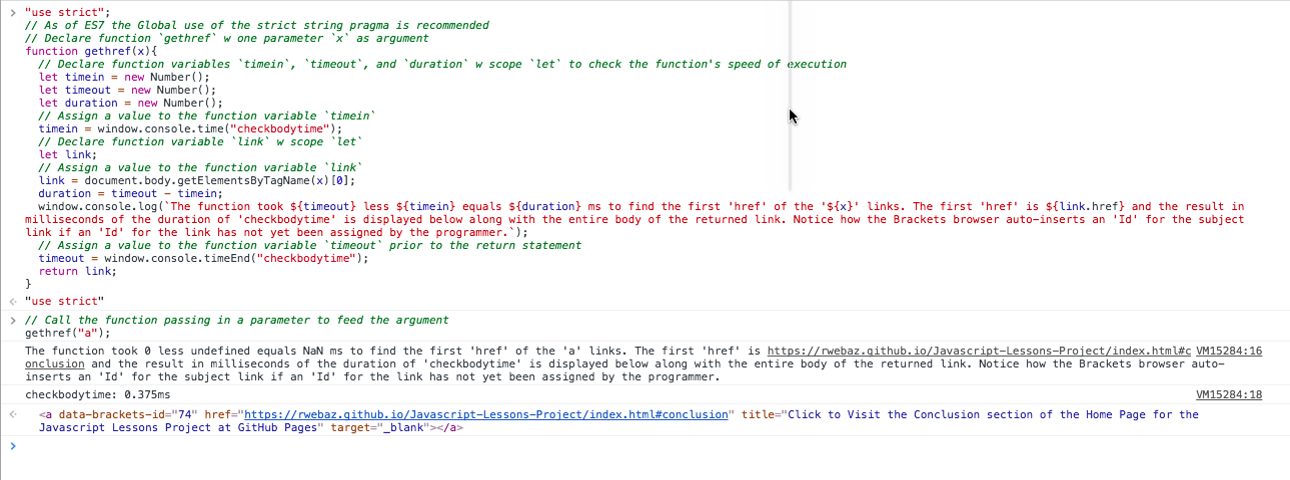Get Elements | Table O Contents
Place the introducing line of text ie.) the ‘tagline’ here …
Note. The Flammarion Logo Badge in the page header above is an .svg image file set to the dimensions of 5% width, auto height, and zoom. Go ahead and test the zoom-out feature by hovering over the badge to engage the expansion of the image.
By Class Name
Hint. Place the intro paragraph ie.) the ‘hypothesis’ here …
function getclass (x, y){
let classes = document.body.getElementsByClassName(y);
document.body.replaceChild(classes[x, y);
return classes.y
}
getclass("green-groove", "red-groove");
Note. In the above getclass function …
-
the DOM is traversed to find all instances of class
y, and -
to replace all instances of class
yfound with classx.
Please remember the first argument of the function takes the parameter x.
The parameter x represents the new or replacing value.
Whereas, the parameter y represents the old or the value being replaced by x.
After traversing the DOM and capturing all of the old y class names, the function then replaces all of the old y class names with new x class name, and then returns the set of classes still of the old y class name of which there should now be none.
Further, the type of the variables x and y, as well as the getclass function will be instantiated and inferred at the time of function execution.
Therefore, there is no need to declare each variable individually, nor is there a need to assign a value to the variables.
The underlying Javascript engine will infer by the structure of the function, and by the type of parameters passed as arguments.
By Tag Name
More to come …
function getpara (x, y, z){
let paragraphs = document.body.getElementsByTagName(x);
document.body.insertBefore(paragraphs[z], paragraphs[y]);
return paragraphs[0];
}
getpara("p", 2, 0);
Note. In the above getpara function …
-
the DOM is traversed to find all instances of
x, wherexrepresents the targeted Tag Name of “p”, for paragraphs. -
Next, the program is instructed to insert before paragraph
y, the paragraphz, wherezrepresents theindexparagraph.
The paragraph[0], commonly known as the index paragraph aka the first paragraph …
- is placed, or inserted before the third paragraph [2] in the sequential series, or order of paragraphs discovered when traversing the DOM.
After traversing the DOM and capturing all of the x tag names of “p”, the function then inserts before the y paragraph[2] …
-
the
zparagraph[0], and -
then returns the new paragraph[0].
As a result of the function, in this case …
-
The old
zparagraph[0] is now holding the second position in the array-like list of paragraphs traversed, as the now paragraph[1] … -
With the
yparagraph[2] now holding the same third position, and -
the old second paragraph[1] now filling the new index position of paragraph[0].
Therefore, the program should return the value of the the old second paragraph[1] now become the index paragraph[0].
Get First Link
An exercise designed to capture the first anchor link of an html page through the Javascript method getElementsByTagName() using the Javascript console of the Chrome browser and the Chrome Developer Toolset, or CDT.
This exercise has successfully yielded the following (.png) and (.log) files, as follows:

function gethref(x){
// Declare function variables `timein`, `timeout`, and `duration` w scope `let` to check the function's speed of execution
let timein = new Number();
let timeout = new Number();
let duration = new Number();
// Assign a value to the function variable `timein`
timein = window.console.time("checkbodytime");
// Declare function variable `link` w scope `let`
let link;
// Assign a value to the function variable `link`
link = document.body.getElementsByTagName(x)[0];
duration = timeout - timein;
window.console.log(`The function took ${timeout} less ${timein} equals ${duration} ms to find the first 'href' of the '${x}' links. The first 'href' is ${link.href} and the result in milliseconds of the duration of 'checkbodytime' is displayed below along with the entire body of the returned link. Notice how the Brackets browser auto-inserts an 'Id' for the subject link if an 'Id' for the link has not yet been assigned by the programmer.`);
// Assign a value to the function variable `timeout` prior to the return statement
timeout = window.console.timeEnd("checkbodytime");
return link;
}
// Call the function passing in a parameter to feed the argument
gethref("a");
Note. In the above gethref function …
-
the DOM is traversed to find the single [0] instance of
x, wherexrepresents the targeted Tag Name of “a”, for anchors. -
Next, the program is instructed to display the
link.hrefof the discovered [0] instance and return the entirelink. -
Along the way, the speed of function execution is timed, as well.
Other Methods
// document.body.appendChild();
And,
// document.body.insertBefore();
Last Subtitle
More to come …
Note. The above synopsis was derived from an article written by Blank Author [1].
Support
Please support the co-workers who aggregate the Source Links for our projects.
Patreon
Like what you see in this project? If so, then support the authors and machine-elves who aggregate the source links and pages for our projects via Patreon.
